Reflecting Elegance: Using Glass in Interior Design for a Modern and Luxurious Touch

Table of Contents
Why glass is a popular material in interior design
Glass is one of the very commonly used materials in interior design, especially after the development of its manufacture and the abundance of its types, so it is used in many different elements in interior design.
We have many types of glass suitable for different purposes at home.
For example, we have toughened glass, frosted glass for visors, stained and colored glass for decoration, and other different types, which we will mention in detail later.
Benefits of using glass in interior design
There are a lot of benefits to using glass in interior design
Allows natural light to enter

Humans need natural light to maintain a healthy lifestyle.
Natural light improves mood and reduces stress, so sunlight in each room is very important to us psychologically, physically, and mentally.

So the glass is used to allow natural light to enter, and the greater the area of light entry, such as windows, ceilings, and pots, the leads to flooding the interior space with light, providing us with electrical energy during the day.
Outward-inward connection

What is more beautiful to enjoy while you are inside your room than a beautiful view outside, even if it is just the view of the clear sky or even the external raindrops?
And we are not just talking about residential spaces; what is beautiful is that the work areas are cheerful and elegant, which is what the use of glass also provides when used in commercial and recreational spaces like restaurants.
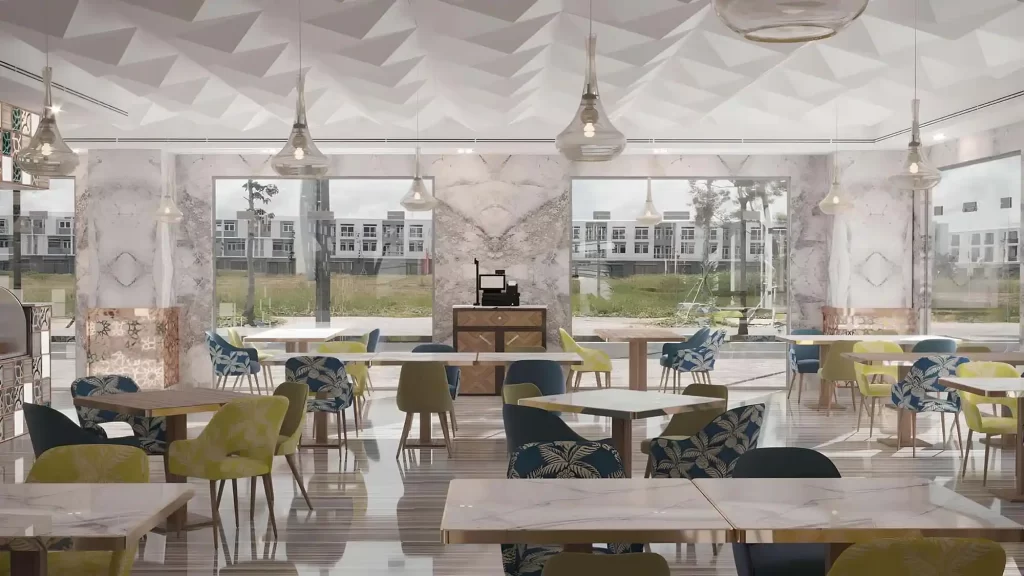
In our design of the Bosporus restaurant, we yearned for a more immersive dining experience that would showcase the stunning external surroundings.
While a standard glass wall may have sufficed, we wanted something more.

That’s why we took it a step further and created a direct connection between the kitchen and the dining hall.
This innovative design provides a sense of transparency and offers the pleasure of watching your food being prepared right before your eyes.
An aesthetic element of glass

As an element that is used a lot in modern designs to give a sense of sophistication and add a special charm and personality to the interior design of the space.
Makes the space appear large

Narrow spaces often give a sense of tightness and discomfort, and if it is not possible to change the dimensions of the room, some modifications can be made that make the space appear larger than it is, such as replacing the walls with a glass wall, whether it is transparent or frosted.
If we want to maintain privacy, simply having A glass wall gives the illusion of spaciousness and brightness, and it is also useful to use reflective glass or mirrors to create a sense of spaciousness, as it reflects nature and brightness.
Easy separation of open spaces
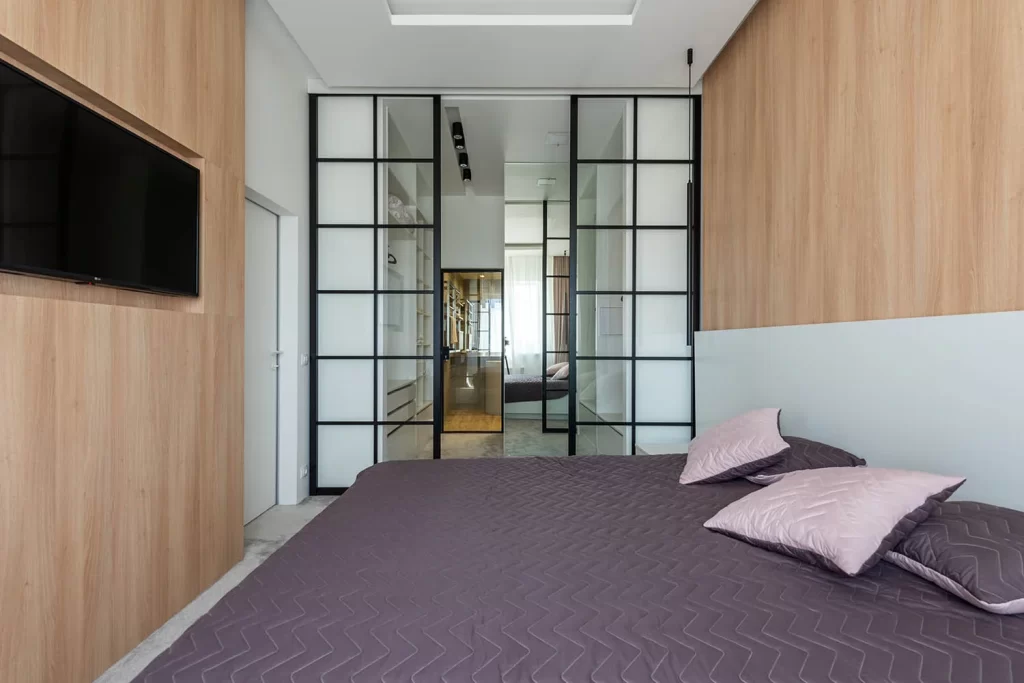
We are often stuck between choosing between Open Plan and Close Plan, whether in residential, service, or offices, as the open plan gives breadth as well as flexibility in moving elements and brushes, but it lacks the privacy provided by the closet.
However, the use of glass, in this case, is the solution to enjoy the advantages of Open Plan and Close Plan.

Using it as dividers allows the flow of light and energy and give a sense of spaciousness as it provides privacy and blocks sound between spaces of the place.
Types of glass used in interior design

There are a lot of types of glass to choose between and our choice of the type of glass used is either decorative or functional.
Glass as a functional element:
Laminated glass

Laminated glass are two layers of transparent glass confined together by a layer of vinyl.
The layers are linked together by applying very high heat and pressure, which gives it hardness and durability It also insulates sound It is used in facades and exterior doors.
It does not crumble thanks to the plastic layer, giving a high degree of safety in case of breakage.
Tempered glass
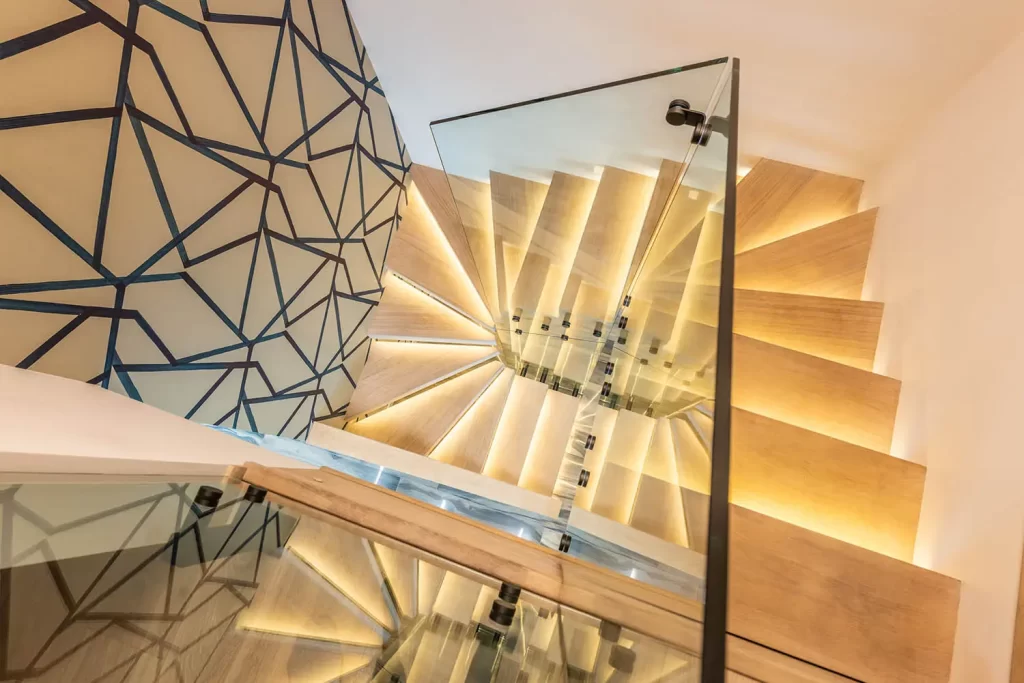
It is characterized by its maximum strength as a result of the way it is manufactured by heating it at a very high temperature and then cooling it quickly, which forms an incredibly durable layer.
It is five times stronger than ordinary glass. It can bear high weights.
Therefore, it is used in glass floors, is also ideal for areas that need high protection, such as stair railings, and is also used in glass heaters.
Acoustic soundproofing glass

Acoustic soundproofing glass is two layers separated by air or insulating material that can sound volume completely, suitable for homes with high noise levels, offices, and recording studios.
Reflective glass

Reflective glass has a mirror-like coating on one side that allows natural light to enter, but it reflects heat and radiation, it gives specificity because it blocks the view from the other side.
Glass as a decorative element:
Choosing glass based on decoration
Clear or float glass

Float glass provides a clear view of the inside and outside Used as a glass wall, glass partitions, table tops, shower partitions for bathrooms, storefronts, and public places.
Colored glass

It is ordinary glass with the addition of a layer of metal oxide that gives it a distinctive color based on the metal used and produces the required colors yellow red green.
It prevents the entry of heat and reduces ultraviolet radiation Keeps cool and is used in places with extreme heat.
Stained glass

Stained glass small pieces of colored glass that are assembled by hand in a lead frame to form beautiful complex designs.
Famous for its use in church windows, but it is also suitable for use in home windows.
Frosted glass
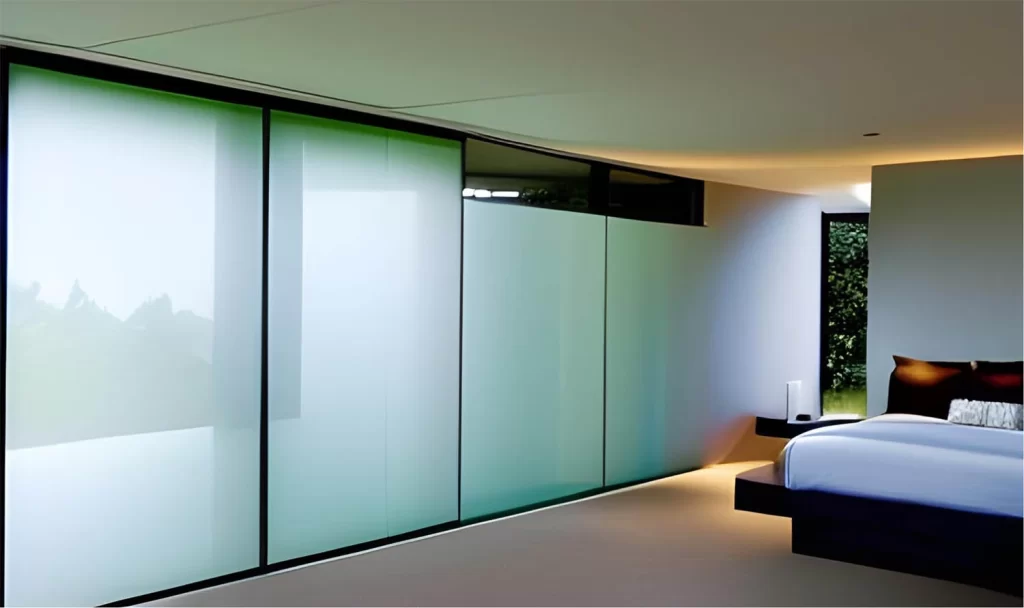
Frosted glass is used for visual privacy if it blocks clear vision but allows air to pass through It is used in dividers and room sections are many and varied shapes according to personal taste and the required degree of privacy.
Glass bricks
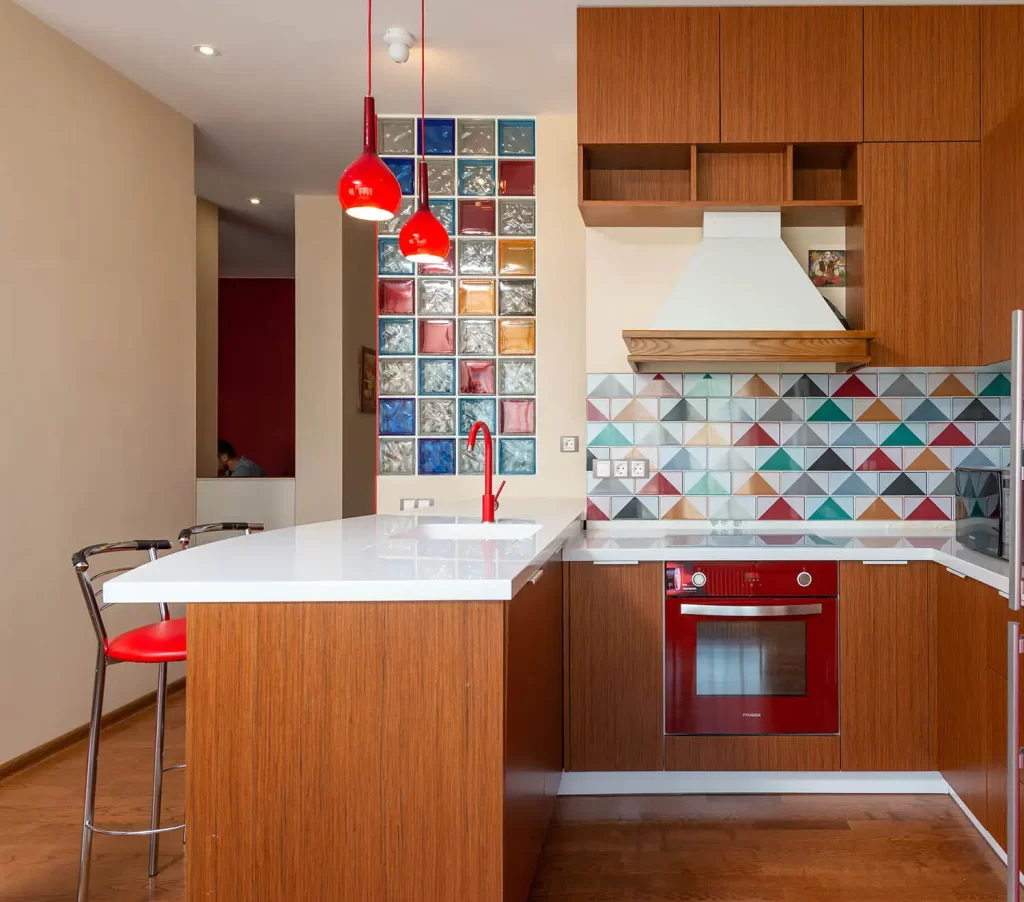
Glass bricks are used in walls and sometimes in partitions and bathrooms.
It gives an aesthetic appearance that passes light through it and has various finishes and sizes and many attractive colors.
LCD privacy glass
What if you are hesitant to choose transparent and frosted glass?
Sometimes you need privacy and sometimes you prefer transparent glass to enjoy full openness.
So the solution is LCD privacy glass.


It is a modern glass technology that enables you with the push of a button to turn transparent glass into a frosted glass that blocks the view by a percentage of 100%.
It is a unique solution to control the privacy of the place while enjoying openness.
Suitable for windows, bathrooms, offices, meeting rooms, and clinics.
It also protects against ultraviolet radiation.
Get inspired by some creative ideas for using glass in interior design
Here are 10 creative ideas for using glass in interior design:
Glass Walls:

One of the most popular ways to incorporate glass in interior design is to use it as a wall.
This is particularly useful in small spaces or apartments where you want to create an illusion of more space.

A glass wall can also be used as a room divider, allowing natural light to filter through and keeping the space feeling open and airy.
Glass Flooring:

Glass floors can add a touch of elegance and sophistication to any room.
They are particularly effective in areas where you want to create a sense of depth, such as in a hallway or stairwell.
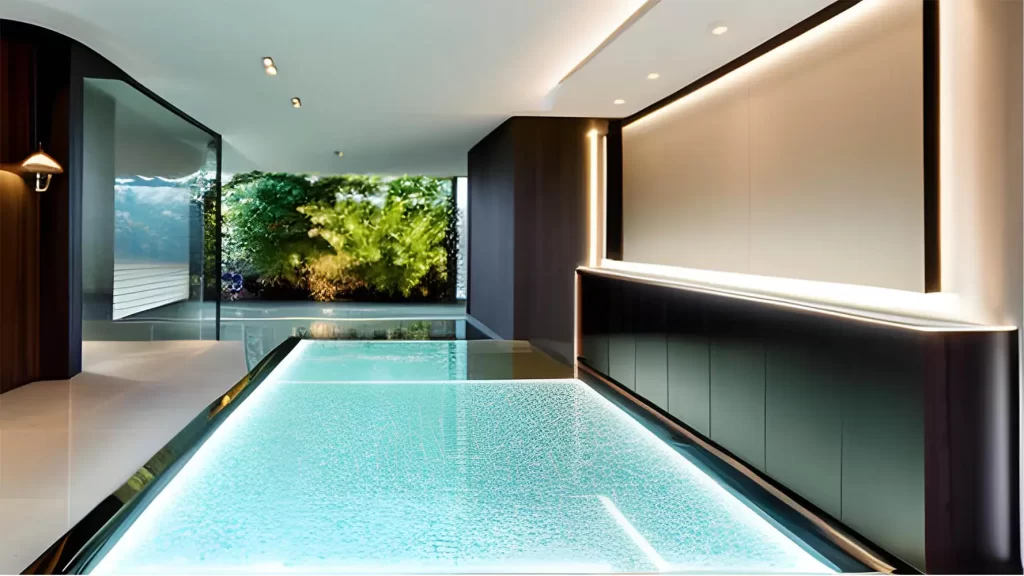
With different textures and finishes, a glass floor can be designed to match any style of interior.
Glass Backsplashes:

Glass backsplashes are a beautiful way to protect your walls from spills and splatters while adding a stylish element to your kitchen or bathroom.

Check full project
Glass is easy to clean and comes in a variety of colors and finishes, making it a versatile choice for any design scheme.
Glass Furniture:

Glass furniture can be used to create a modern and sleek look in any room.
Glass coffee tables, end tables, and dining tables are popular choices, as they are easy to clean and maintain.
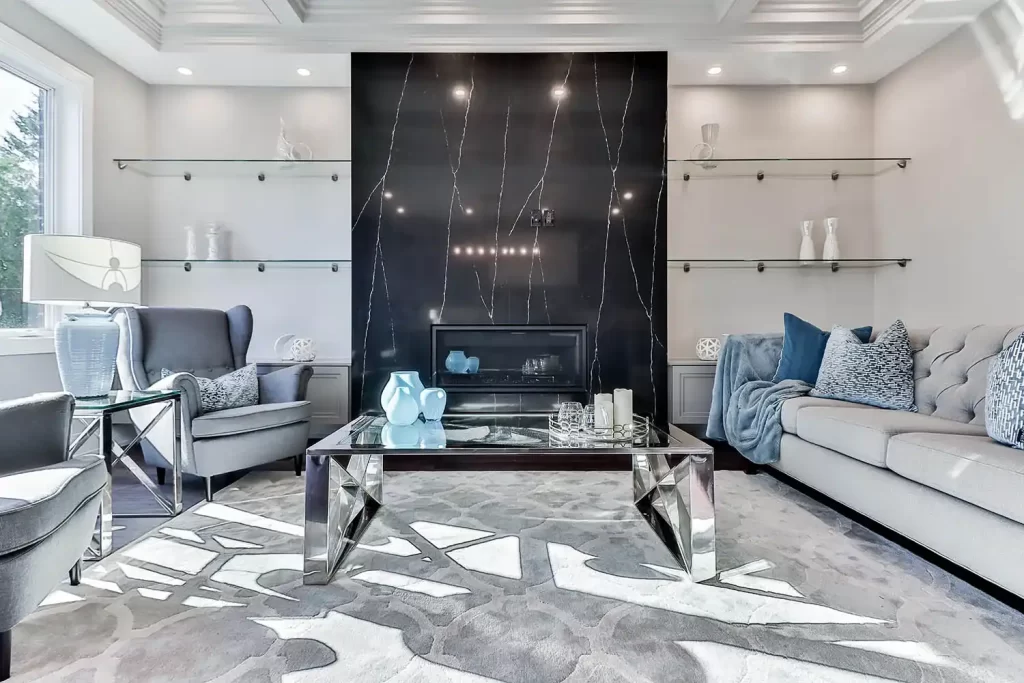
Glass shelving can also be used to display decorative items or store books and other items.
Glass Lighting Fixtures:
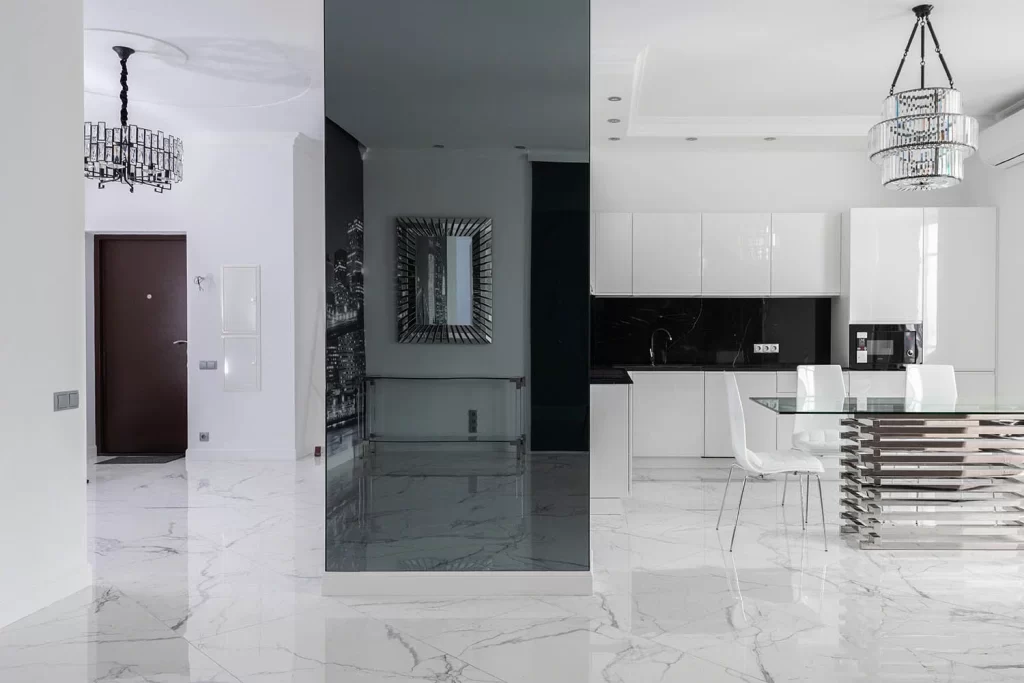
Glass lighting fixtures can add a touch of sophistication and elegance to any room.
Glass pendant lights are a popular choice, as they can be hung individually or in groups to create a stunning visual effect.
Glass chandeliers are another option, adding a touch of luxury and glamour to any space.
Glass Doors:
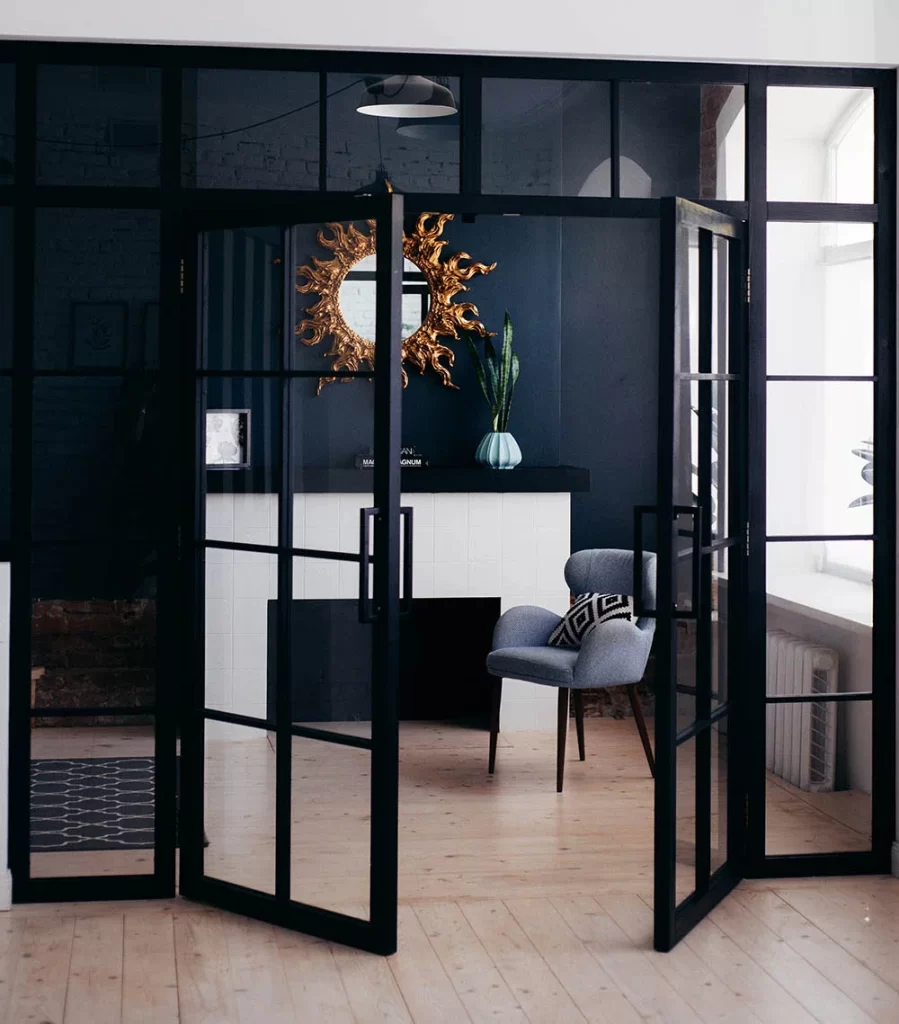
Glass doors are an excellent way to let natural light into a room while also creating a sense of separation.

Glass doors can be used for interior doors, such as in a home office or bedroom, or as exterior doors, such as a patio or balcony door.
Frosted or textured glass can also be used for privacy.
Glass Countertops:

Glass countertops are a unique and modern choice for any kitchen or bathroom.
They can be made from a single sheet of glass or from smaller pieces that are fused.
Glass countertops are durable and easy to clean and come in various colors and finishes.
Glass Partitions:

Glass partitions are a stylish way to separate different areas of a room while still maintaining an open and airy feel.
They can be used in a variety of settings, from offices to restaurants to homes.
Glass partitions can be customized with frosted or etched designs for added privacy.
Glass Art:

Glass art can be a beautiful and unique way to add color and texture to a room.
Stained glass windows or glass sculptures are popular choices, as they can create a focal point in a room.

Glass art can also be functional, such as a glass vase or bowl that can be used for flowers or fruit.
Glass Accents:

Glass accents are a simple way to add a touch of elegance and sophistication to any room.
Glass knobs or pulls can be used on cabinets or drawers, and glass tiles can be used as a backsplash or accent wall.
A glass mirror or picture frame can also add a touch of glamour to a room.
It is also essential to mention that glass is a remarkable eco-friendly material.
Its inherent sustainability makes it a popular choice for environmentally conscious individuals.
Glass is endlessly recyclable, meaning it can be repurposed and transformed into new products without losing quality.
By opting for recycled glass in interior design, we reduce the demand for raw materials, conserve energy, and diminish landfill waste.
By embracing glass in interior design, we make a sustainable choice that promotes a greener future while adding an elegant touch to our living spaces.
